|
FAQs about Sea Star Identification
6
Related Articles: Sea
Stars, Brittle Stars,
Asterina Stars,
An Introduction to the
Echinoderms: The Sea Stars, Sea Urchins, Sea Cucumbers and
More... By James W. Fatherree, M.Sc.
Related FAQs: Sea
Star ID 1, Sea Star ID 2,
Sea Star ID 3, Sea Star ID 4, Seastar ID 5, Seastar ID 7, Seastar ID 8, Seastar ID 9, & CC Star Identification,
Linckia Identification,
Sandsifting Star
ID, & Sea
Stars 1, Sea Stars 2, Sea Stars 3, Sea
Stars 4, Sea Stars 5, Brittle Stars, Seastar Selection, Seastar Compatibility, Seastar Systems, Seastar Behavior, Seastar Feeding, Seastar Reproduction, Seastar Disease, Asterina
Stars, Chocolate Chip Stars,
Crown of Thorns Stars,
Fromia Stars,
Linckia Stars, Linckia Stars 2, Sand-Sifting Stars,
|
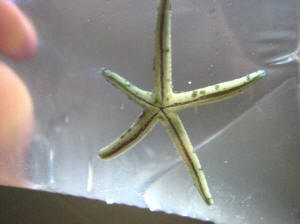
|
|
Starfish ID 9/17/13
Hi, I was wondering if you'd be able to ID this starfish for me. It has
about 10 legs with an orange centre and is bluey/purpley around the edges.
<I see>
So far the closest thing I've seen close to it is a common sea star but I
think it's smoother than that is and may be a species of Asterina, I'm not
sure though.
I've attached a couple of pics I got of it.
Thanks, Ryan.
<I too make this out as Asterina sp.. Predaceous on some Cnidarian groups.
Do see/read re the genus on WWM.
Bob Fenner>
|
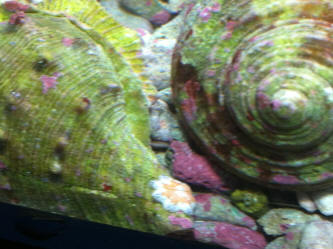
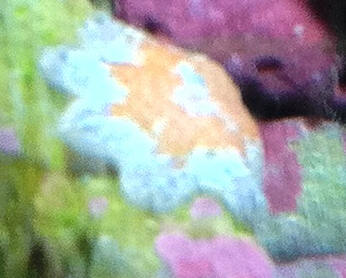 |
|
Need Help ID'ing These Stars: Gomophia and
Possible Fromia spp. 8/7/10
Hello Crew,
<Hello Jeanne, Lynn here today.>
I took the photos of these specimen off Sharm El
Sheikh/Na'ama Bay either in Ras Mohammed National Park (Shark
and Yolanda) or the Sinai side of Tiran Island (Jackson or Thomas
or Woodhouse). Neither are in my two guides from the area and I
would like to know what they are.
<The brownish star looks like Gomophia egyptiaca, commonly
known as the Egyptian Seastar. See the photo at this link for
comparison:
http://www.diverosa.com/categories/Starfish&Brittlestars.htm .
The closest I can get to the individual with blue dots is Fromia
ghardaqana, aka the Ghardaqa Seastar:
http://www.diverosa.com/Egypt%20WL/Ghardaqa%20seastar,%20Fromia%20ghardaqana%20.html
http://www.flickr.com/photos/26196286@N02/3265037638
Thanks, Jeanne
<You're very welcome. Take care, Lynn Z>
PS. If Bob is leading any dive trips I am very interested in
learning about them so that I can sign up!
<RMF'¦?>
|
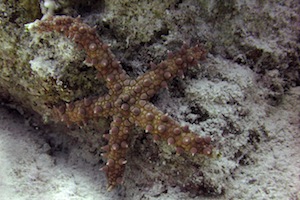 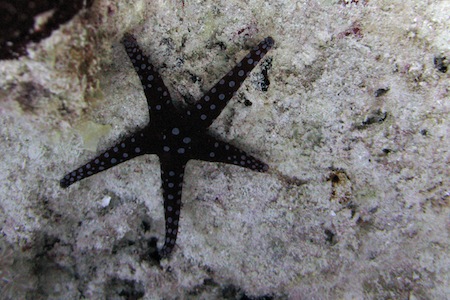 |
Starfish, Asterina? 9/16/08
Hi Bob, <Hi, but not Bob, Chris here.> I live in Louisiana and I
lost power for about a week due to hurricane Gustav. I have a 29gal
FOWL tank that has about 30 pounds of live rock and 1 inch of live
sand. A percula clown and a polyp colony were the only things in the
tank and they made it through the outage. <Sorry> The tank has
been running for about 9 months. When I returned home I noticed 4 to 5
small starfish that I had never seen before. They are all missing at
least 2 legs and are white on the bottom with a little brown on the
top. I am guessing that they came out because the lights were off for
so long. The power has been back on for about two weeks now and I still
see them occasionally. <Most likely Asterinas, common in many tanks.
http://www.wetwebmedia.com/asterinaidf.htm > I was wondering why
they are coming out now and what kind they may be? <Their numbers
are most likely increasing due to the die off and increased food
sources after the power outage.> Also, could they be harmful to
anything else in the tank? <Doubtful.> Thanks very much (Your
book The Conscientious Marine Aquarist got me into the hobby) Adam
<Chris>
|
Starfish Identification -- 07/28/08 Hi Crew,
<Hello Laurie.> First off, let me say thank you for the
time all of you spend writing articles and answering hobbyists
e-mails! <Thanks for your kind words.> Many of my questions
have been answered by browsing through your site. <Very
good.> A couple months ago I purchased a 'chocolate
chip' starfish although I am not sure if that is actually
what it is. Of all the chocolate chip starfish pictures and
animals I have seen, I have not seen one quite like this. The
attached photos show the front and back of the starfish I
purchased. It does appear to be a meat eater as the it readily
accepts chunks of raw muscles and raw/cooked shrimp. <Ah, yes.
The entire family (Oreasteridae) are omnivores with carnivore
tendencies, mostly eat bivalves in nature, but some also soft
corals. It appears to be a Protoreaster, but not one of the two
common species (P. nodosus and P. linckii). Its coloration on the
picture somewhat resembles Pentaceraster mammilatus and P.
tuberculatus, but the shape does not. Compare to
http://www.wetwebmedia.com/seastarfaq5.htm. I'd ID it so far
as Protoreaster sp., but with the animal in front of you, maybe
you see more resemblance with one of the Pentaceraster spp. Care
for them is the same anyway. All can reach a diameter of 1
foot.> I have another question too, in the background of the
photos I am sure that you can see the diatoms that have built up
on the glass. Are diatoms indicative of nutrient buildup in the
water and an indication that I need to do more water changes?
<They are either indicative of a very young system or too much
silicon (not silicone) in the water. Should go away by themselves
if you use silicon free water for water changes.> Do I just
need to wipe off the glass more? <You can do that.> Do I
need more water movement? <Should be sufficient, but more can
be added if you see too much detritus accumulating.> The
aquarium is a 20T with 20 lbs of live rock, a Top Fin Powerhead
30, and a CPR Bak-Pak 2 protein skimmer. I try to do a bi-weekly
water change of 3 gallons, but honestly, I do not meet this goal
100% of the time. <Nitrate measurements are a good indicator
for water changes.> In habitants of this aquarium include the
following: - starfish in the photos - another chocolate chip
starfish - 2 blue legged hermit crabs + 3 new hermit crabs added
yesterday - a small cleaner shrimp - a pink/blue spotted watchman
goby - 2 Astrea snails added yesterday <Snails may be eaten if
the starfish can get them.> Thanks you so much for your time,
Laurie
<You are welcome. Marco.>
|
|
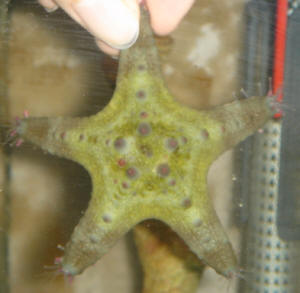 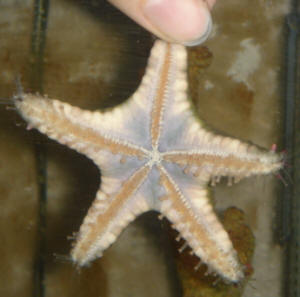
|
| ID please - some sort of star? -- 06/04/08 Hello,
<Hi> I found this thing in the tank - it is approximately
1/4" in diameter, perhaps 3/16". I used a macro lens to
capture it up close. I do not know what it is - my tank is
approximately 3 weeks old and this is the first time I've seen
it. The lights were on and had been on for 8+ hours so it
apparently isn't afraid of lights. <Nice picture.> Any
idea what it is? If I should remove it, how should I pull it out? I
assume it is not safe to handle without using tweezers, etc. <It
looks like an Asterina star. See
http://www.wetwebmedia.com/asterinafaqs.htm . Some report problems
with them, when they occur in large numbers and use Harlequin
shrimp http://www.wetwebmedia.com/harlequinshrimp.htm with all the
associated problems to get rid of them. However, they behave well
and are very beneficial in the majority of reef tanks. I would
leave it in there. They can be touched or collected with tweezers
or hands.> <You are welcome. Marco.> |
|
 Very nice pic! RMF Very nice pic! RMF
|
|
Star ID Please'¦ Fromia (monteporella
or ghardaqana) 3/17/08 Hello Crew, <Hi there
Nick, Mich here.> I have a star that I need help in
identifying. <OK, lets see what we can do! Is a Fromia from
the Red Sea. Looks like a Ghardaqa brittle star (Fromia
ghardaqana) or possibly an elegant sea star (Fromia milleporella)
http://www.wetwebmedia.com/seastars.htm According to Nilsen and
Fossa, the blue spotted version of the Fromia Milleporella is
from the Red Sea, though I wonder if it was incorrectly
identified in the "Reef Secrets" book. unfortunately
these beautiful creatures, along with most all sea stars do not
do well in captivity and usually slowly die from starvation. I
would urge to avoid buying any sea stars in the future. Instead
consider a red/ruby brittle star (Ophioderma spp.) as seen here:
http://www.wetwebmedia.com/brittlestars.htm > I figure I'd
ask the pro's. <Heehee! Well I'm not a pro. The only
Pro I Know is Steven! Heehee!> I hope all is well. <Tis!
Thank you! Wish you well.> Thanks, Nick. <Welcome, Mich>
http://s177.photobucket.com/albums/w227/milesqreefer/?action=view¤t=117
_1784.jpg
http://s177.photobucket.com/albums/w227/milesqreefer/?action=view¤t=117_1784.jpg
|
|
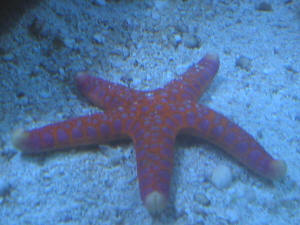
|
|
Sand-sifting Starfish'¦
Reproduction'¦ Doubtful'¦ Likely
Asterinas 3/12/08 Dear WWM: <Hi Suzanne, Mich
here.> First of all, thank you soooo much for the wealth of
information that you provide. It has been invaluable to me.
<To me too! Is how I learned as well.> My son-in-law got me
started on saltwater fish and I have thoroughly enjoyed it.
<Congrats! Welcome to the club!> I had a 30-gallon tank
(have since graduated to 75 gal.) and in it I had a Sand-sifting
Starfish among other things. The Star was about 3.5 inches in
diameter and was so much fun as I watched him disappear in the
sand and climb the sides of the aquarium. <And decimated your
sand bed?> After about 8 months he started to look thin.
<Starfish generally starve to death in captivity, sand sifting
included.> I gave him to my son-in-law and it did better for
several months and then wasted away and died. <Starved.>
Not long after that he started noticing these tiny white specks
in his tank - hundreds of them. As they grew, we realized that
they were Starfish! Some had five arms, others had three or four
(fish probably were munching on them). Now they are about 3/8
inch in diameter and it looks like someone poured a can of
Campbell's Chicken and Stars soup in the tank! <Just as
likely to be Campbell's as baby sand sifting stars.> When
the tank is dark they are all over the front and sides of the
glass. It is incredible. What is more incredible is that there
was only ONE Starfish to start with. How in the world did that
Starfish reproduce?? <It didn't.> I read all that you
had on Starfish on your site and it talks about mating. There was
no mate to mate with. <I would be shocked if it wasn't an
entirely different species, likely Asterina by the sounds of
it.> I took six home and put in my tank. When and if they get
bigger I will give the surviving ones to our LFS and keep only
one for my tank. <Mmm, do they look like this?
http://www.wetwebmedia.com/asterinafaqs.htm
http://www.wetwebmedia.com/asterinaidf.htm > What are your
thoughts on this phenomenon? <I don't think it's a
phenomenon.> What is my son-in-law to do with all those
starfish. <Mmm, Harlequin shrimp? Just kidding. I don't
recommend to anyone who is not seriously committed to keeping
these beautiful shrimp that only eat live starfish. Please
don't go buy one to combat your starfish issue.> There are
certainly not enough nutrients in his sand bed for all of them.
<Might be for Asterinas, they are generally self limiting.>
Should he wait and see how big they get assuming they may not
survive for very long of get them out of the tank now? That will
be no small chore!! <Lets determine what is actually in the
tank before crossing this bridge.> Sincerely Suzanne <Any
chance of getting a picture? Cheers, Mich>
Sand-sifting Starfish'¦
Reproduction'¦ Doubtful'¦ Likely
Asterinas'¦ Is Asterina 3/13/08 Dear
Mich: <Hi Suzanne!> Thanks for your response.
<Welcome!> I have four pictures for you. <Excellent!
Thanks for capturing some images.> I would have liked to have
gotten you a view when he (she? it?) was on the glass, but I
haven't seem them on the glass in my tank in about a week.
<No worries.> In fact I though they might have died.
<Not necessarily a bad thing per se. Some folks report some
species of Asterina to be predatory on Zoanthids> It looks
exactly like a miniature sand-sifter to me and he moves very
sloooow like one. I can see why you would question that. What do
you think from the picture? I wasn't familiar with Asterinas.
<You have Asterina stars.> Thanks,
Suzanne
<Welcome! Mich>
|
|
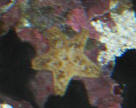
|
| Starfish Identification? 03/11/2008 A friend
of mine was diving in the Gulf Of Mexico off Florida's west
coast and thought he was doing me a favor by bringing back two
starfish for me. I have had them in an isolation tank for a month
now trying to look at pictures and figure out just what these are.
I searched geographically and can't seem to find anything.
Wondering if these are going to last or if they are reef safe. Well
actually a scientific name would be all I need to do some research.
<<From what I can make out from the pictures, I would say
that is a Echinaster spinulosus>> I have spent a month
looking on and off and am ready to throw in the towel so figured I
would shoot you off some pictures and you can put me out of my
research misery. Thanks for any help ! Ralph <<Hope this
helps. A Nixon>> |
|
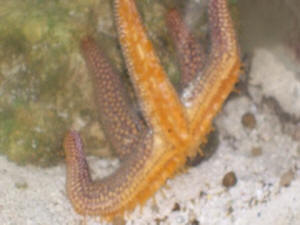
|
| Seastar ID 03/12/2008 Hi Crew,
<<G'Morning, Andrew today>> I purchased an unusual
looking Seastar for my tank and I cannot seem to find it on the
web. I was figuring you can help me ID it. I've enclosed a
picture of it. It looks like a chocolate chip star but has blue,
yellow and black on its legs with crimson color at the peak of the
"chips". Even after five years in the hobby, I saw it and
made the impulse purchase before reading about the animal or really
asking the vendor. <<Yes, this is a Protoreaster SP.
star...Should be treated as the same as a CC star>> For now,
I'll treat it as a c.c. star and put it in my macro algae tank
instead of my reef tank. I'd appreciate any help you can give
me so I can take care of my new pet. Thanks, <<Thanks for the
question. A Nixon>> |
|
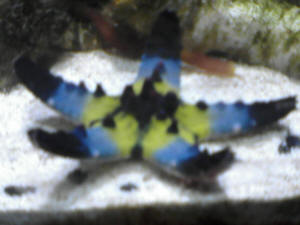
|
|
Starfish Identification: Cushion star? - 12/31/07 Hi Bob
and Crew <Hi Claire. I sincerely apologize for the delay in
responding!> Got this lovely starfish as a hitchhiker, but
don't know what species it is, or if it is coral friendly -
any ideas?? <It is indeed a lovely little sea star!
Unfortunately, after going through every resource at hand,
I'm stumped as to what species it is. It could be a juvenile
that looks very different from its mature counterpart, or simply
a species that hasn't been photographed/identified in my
sources. It does look a bit like a Cushion/Biscuit star, however,
so I'd keep an eye on it and your corals.> Thanks Claire
<You're very welcome! I just wish I could have been more
help! --Lynn> <<Mmm, maybe an Asterina sp.... A.
phylactica? http://www.asturnatura.com/photo/photogallery/galerias.php?photo_id=583
RMF>>
Re: Starfish identification -- 1/2/08
<<Mmm, maybe an Asterina sp.... A. phylactica?
http://www.asturnatura.com/photo/photogallery/galerias.php?photo_id=583
RMF>> <Thanks, Bob! I spent way too long yesterday
looking for that little guy. I finally found something that
looked about right, but it was a photo at a dead link. Talk about
frustrating! I wasn't happy with the general answer I gave,
but thought I'd exhausted all possible sources in the search.
Well, I got up this morning with that little star still on my
mind, so I cued up Bob Marley, and did a little more digging.
This time I found the current link for that photo. I'm not
sure if what's shown is the same star, but the similarities
are promising. They have the same general coloring, same markings
between the arms, and what looks like at least a partial ring on
some. It's hard to believe all those are the same species,
but I guess they vary quite a bit. Here's the link: http://www.bluering.org.au/chpt17b.htm . What do you
think? -Lynn> >Does look like Tosia australis...
RMF<
|
|
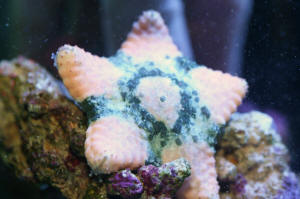
|
|
Hitchhiking Star ID... Reef Safe? - 12/13/07 <Hi
Wes> I found this lil' bugger and nabbed him up so that
hopefully I can get an ID. What you see is about all I know! My
first guess was Fromia elegans, but looking at the google pics,
I'm thinking not. So, I formally submit my guess of Linckia
multifora. Ehh? Ehh? Ahhh, lemmie know whatcha think. <I think
I'm having a hard time distinguishing the color(s) of those
splotches on the dorsal side! However, based on your tentative
Id, I'm guessing they're reddish. What you have could
indeed be Linckia multifora, or something along the lines of
Leiaster coriaceus. Please see the following links for
comparison/info:
http://www.saltcorner.com/sections/zoo/inverts/echinoderms/starfish/Lcoriaceus.htm,
http://www.advancedaquarist.com/issues/may2002/toonen.htm
Unfortunately, I can't answer with any certainty whether this
creature will be reef safe, or not. Time, and observation, will
tell.> Wes <Take care -Lynn>
Re: Hitchhiking Star ID... Reef Safe? -
12/14/07 <Hi, Wes> One of the reasons I had a hard time
deciding on a solid ID was because the spots are most certainly
not red or even reddish... They are a dull brown, with a light
grayish/brown background. Does that help at all? <Hee - well,
sort of! Linckias can vary a great deal in color/pattern.
I've looked through every resource at hand and still
don't have a match. Along with the 'typical' red
mottled individuals, I've seen a photo of a supposed L.
multifora that was a bright pink/magenta combo! Check it out:
http://www.meerwasser-lexikon.de/eng/76/1736/Linckia/multifora.htm.
I've seen others that were more of a solid yellowish brown
(no real mottling), one that was a mottled yellow and light
brown, and one possible ID that was a mottled blue! I can't
find much in the way of photos on Leiaster coriaceus, but one
other I did see this morning, barely looked like the one I
mentioned yesterday (in color/pattern). Talk about confusing! You
could have a species I/we haven't run across in our
searching, or simply a color variant of one we have. It's
also possible that the star you have used to be a different
color, but due to conditions it was in previously, has
altered/discolored (maybe diet related as well). Lighting is also
a factor for how the color appears (in photos, as well as in the
aquarium). Bottom line -- I'm sorry as can be, but I still
can't narrow down what species you have.> Still <Me
too!>
Wes
<Take care -Lynn>
|
|
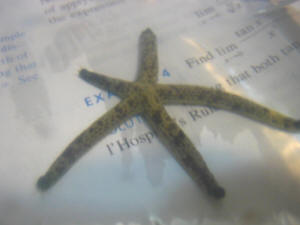 
|
|
|

